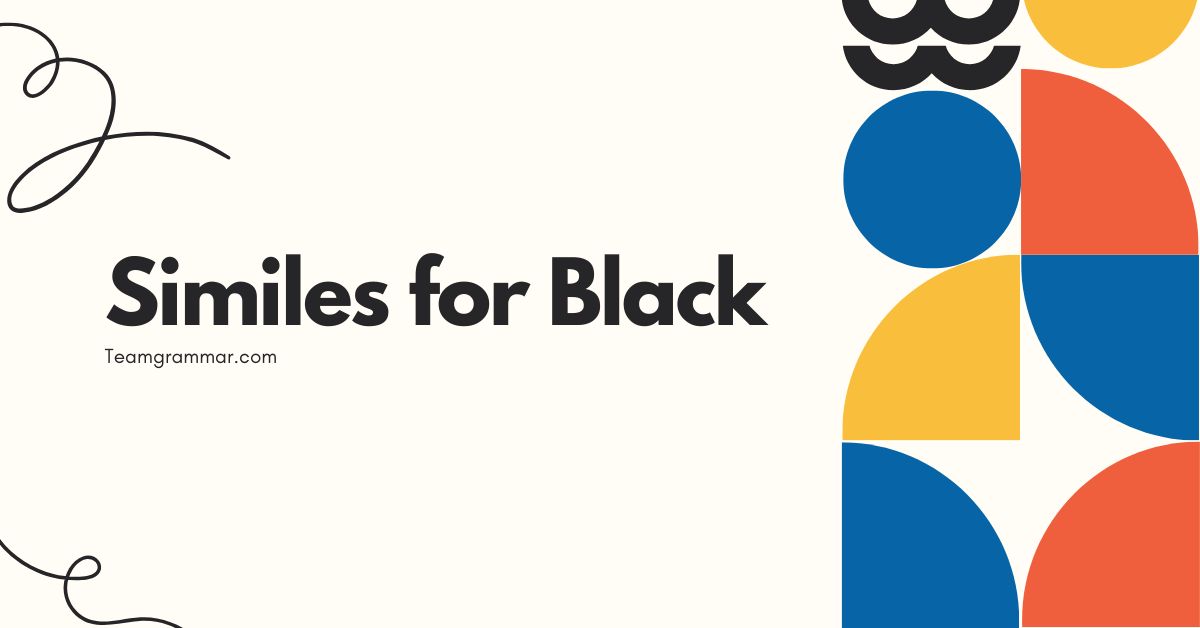33 Similes for Black: Enhancing Descriptive Writing
Understanding and using similes effectively is crucial for vivid and engaging writing. Similes, by comparing one thing to another using ‘like’ or ‘as,’ allow writers to paint more detailed and evocative pictures with their words.
This article focuses specifically on similes that describe the color black, exploring various comparisons and their nuances. Mastering these similes will enrich your vocabulary and improve your descriptive writing skills, whether you’re a student, a creative writer, or simply someone looking to enhance their communication.
Table of Contents
- Introduction
- Definition of Similes
- Structural Breakdown of Similes
- Types of Similes for Black
- Examples of Similes for Black
- Usage Rules for Similes
- Common Mistakes with Similes
- Practice Exercises
- Advanced Topics in Similes
- FAQ Section
- Conclusion
Definition of Similes
A simile is a figure of speech that compares two unlike things using the words “like” or “as.” It’s a powerful tool for creating vivid imagery and enhancing understanding by relating something unfamiliar to something familiar. Similes fall under the broader category of figurative language, which includes metaphors, personification, and other techniques that deviate from literal meaning to achieve a more expressive effect.
The primary function of a simile is to create a clearer, more imaginative, or more impactful description.
Similes are used in various contexts, including literature, poetry, everyday conversation, and persuasive writing. They help writers and speakers convey complex ideas or emotions in a more accessible and relatable way.
By drawing a comparison, a simile can highlight specific qualities or characteristics of the subject being described, making the description more memorable and engaging. The effectiveness of a simile depends on the aptness of the comparison and the clarity with which it conveys the intended meaning.
Structural Breakdown of Similes
The basic structure of a simile involves three key components: thesubject, thelinking word(“like” or “as”), and thereferent. The subject is the thing being described, and the referent is the thing it is being compared to.
The linking word establishes the comparison between the two. Understanding this structure is fundamental for constructing effective and grammatically correct similes.
For example, in the simile “The night was as black as coal,” “the night” is the subject, “as” is the linking word, and “coal” is the referent. This structure can be modified slightly depending on the desired emphasis or stylistic effect, but the core elements remain the same.
Variations might include inverting the order or adding descriptive adjectives to either the subject or the referent.
Thelinking wordis crucial because it signals that a comparison is being made, distinguishing the simile from a metaphor, which implies a direct equivalence. The choice between “like” and “as” often depends on stylistic preference or the specific phrasing of the sentence, but both serve the same fundamental purpose of establishing a comparison.
Proper use of these structural elements ensures that the simile is clear, concise, and effective in conveying the intended meaning.
Types of Similes for Black
Similes Based on Darkness
These similes directly compare the subject to things known for their intense darkness. They emphasize the deep, impenetrable quality of the blackness.
These are often the most straightforward and commonly used similes for describing black.
Similes Based on Texture
These similes focus on the texture associated with black objects, such as smoothness or roughness. This adds a tactile dimension to the description, engaging the reader’s sense of touch.
Describing something as “black as velvet” evokes a feeling of smoothness and richness, while “black as soot” suggests a rougher, dirtier texture.
Similes Based on Emotional Associations
These similes use black to evoke certain emotions, such as sadness, fear, or mystery. This type of simile relies on the symbolic meaning of black in different cultures and contexts.
For example, “black as despair” connects the color to a feeling of hopelessness, while “black as a moonless night” can create a sense of foreboding.
Similes Based on Objects
This category includes similes that compare black to specific objects, such as ravens, shadows, or obsidian. The effectiveness of these similes depends on the reader’s familiarity with the object and its associated qualities.
Describing something as “black as a raven’s wing” relies on the reader’s understanding of ravens as dark and sleek birds.
Examples of Similes for Black
Below are several tables providing diverse examples of similes for the color black, categorized by the aspects they emphasize. Each example is designed to illustrate how different comparisons can create varying effects and nuances in descriptive writing.
These examples should give you a strong foundation for crafting your own similes.
Examples Emphasizing Darkness
This table showcases similes that directly emphasize the depth and intensity of blackness. They are useful for conveying a sense of profound darkness and obscurity.
Study how the different referents contribute to slightly different shades of meaning. Before inspecting the table, consider how you might describe the night sky.
| Simile | Explanation |
|---|---|
| As black as pitch | Pitch is a very dark, sticky substance, often used to describe deep darkness. |
| Like a bottomless pit of black | This evokes a sense of endless, unfathomable darkness. |
| As black as the void | The void refers to the emptiness of space, suggesting a complete absence of light. |
| Black like a starless night | Emphasizes the absence of light, creating a sense of profound darkness. |
| As black as coal | Coal is a common reference point for blackness, familiar and easily understood. |
| Like the blackest ink | Ink is known for its deep, opaque black color. |
| As black as a shadow | Shadows represent the absence of light and are naturally dark. |
| Black like a cave | Caves are often dark and enclosed spaces, symbolizing deep darkness. |
| As black as the devil’s heart | This simile adds a sinister and ominous tone to the description. |
| Like a black hole | A black hole is a region of spacetime with such strong gravitational effects that nothing can escape from it. |
| As black as midnight | Midnight, the darkest part of the night, serves as a strong reference for blackness. |
| Black like obsidian | Obsidian is a volcanic glass that is typically black in color. |
| As black as a raven’s wing | Ravens are known for their dark, glossy feathers. |
| Like the inside of a tomb | Tombs are typically dark and enclosed, symbolizing finality and darkness. |
| As black as a moonless night | A moonless night is exceptionally dark, lacking any lunar illumination. |
| Black like crude oil | Crude oil is a thick, dark substance when extracted from the earth. |
| As black as tar | Tar is a thick, dark, sticky liquid, often used in road construction. |
| Black like a burnt offering | This simile adds a sense of destruction and finality. |
| As black as a chalkboard | Chalkboards, when clean, are a deep, matte black. |
| Black like the pupil of an eye | The pupil, which absorbs light, appears as a dark circle in the eye. |
| As black as licorice | Licorice is a candy known for its distinctive black color. |
| Black like an abyss | An abyss is a deep, immeasurable space, often associated with darkness. |
| As black as India Ink | India ink is renowned for its rich, dark black pigment. |
Examples Emphasizing Texture
This table provides examples of similes that focus on the texture associated with black objects, adding a tactile dimension to the description. These similes can evoke feelings of smoothness, roughness, or other tactile sensations.
Before inspecting the table, consider how you might describe silk.
| Simile | Explanation |
|---|---|
| As black as velvet | Velvet is known for its smooth, soft texture, implying a luxurious blackness. |
| Like black silk | Silk is smooth and lustrous, adding a sense of elegance to the description. |
| As black as soot | Soot is a fine, powdery substance, suggesting a dirty or grimy blackness. |
| Black like asphalt | Asphalt has a rough, grainy texture, implying a coarse blackness. |
| As black as leather | Leather can be smooth or textured, depending on the type, adding a sense of durability. |
| Like a black stone | Stones can be smooth or rough, adding a sense of solidity and permanence. |
| As black as a chalkboard | A chalkboard has a slightly rough texture, providing a tactile contrast. |
| Black like a vinyl record | Vinyl records have a smooth, glossy surface. |
| As black as a cast-iron skillet | Cast iron has a rough, slightly oily texture. |
| Like black sand | Black sand is gritty and coarse, offering a tactile contrast. |
| As black as charcoal | Charcoal is brittle and slightly rough. |
| Black like ebony | Ebony is a dense, black hardwood with a smooth finish. |
| As black as anthracite coal | Anthracite coal is hard, glossy, and smooth. |
| Black like a well-worn tire | The rubber of a tire can be smooth and worn. |
| As black as a polished gem | Polished gems have a smooth, reflective surface. |
| Black like a crow’s feather | Feathers are generally smooth and soft. |
| As black as a licorice whip | Licorice whips are smooth and slightly sticky. |
| Black like a blackberry | Blackberries have a bumpy, textured surface. |
| As black as a truffle | Truffles have a rough, earthy texture. |
| Black like a seal’s fur | Seal fur is dense, soft, and smooth. |
Examples Emphasizing Emotional Associations
This table demonstrates similes that use black to evoke specific emotions, such as sadness, fear, or mystery. These similes rely on the symbolic meaning of black in different cultural and personal contexts.
Before inspecting the table, consider how you might describe sorrow.
| Simile | Explanation |
|---|---|
| As black as despair | Connects black to a feeling of hopelessness and deep sadness. |
| Like a black mood | Implies a feeling of gloom and negativity. |
| As black as sorrow | Equates black with a profound sense of sadness and grief. |
| Black like a funeral shroud | Evokes a sense of mourning and finality. |
| As black as a guilty conscience | Connects black to feelings of remorse and wrongdoing. |
| Like a black secret | Implies something hidden, mysterious, and potentially sinister. |
| As black as a broken heart | Relates black to the pain and emptiness of heartbreak. |
| Black like a dark omen | Suggests a sense of foreboding and impending doom. |
| As black as a witch’s brew | Evokes a sense of mystery and magic, often with negative connotations. |
| Like a black curse | Implies a sense of misfortune and malevolence. |
| As black as a villain’s soul | Connects black to evil and moral corruption. |
| Black like a mourning veil | Veils are worn during mourning and are often black. |
| As black as a thief’s heart | Thieves are often associated with darkness and secrecy. |
| Black like a shadow of doubt | Doubt is a feeling of uncertainty and darkness. |
| As black as a threat | Threats are ominous and often shrouded in darkness. |
Usage Rules for Similes
The primary rule for using similes is to ensure that the comparison is both logical and effective. The two things being compared should share a relevant characteristic that is being highlighted.
The simile should also enhance the reader’s understanding or create a more vivid image. Avoid clichés and strive for originality in your comparisons.
Clarity is key. The simile should be easily understood by the reader, and the connection between the subject and the referent should be clear.
If the comparison is too obscure or convoluted, it will fail to achieve its intended effect. Consider your audience and their familiarity with the referent when choosing a simile.
What might be obvious to one person may be confusing to another.
Consistency in toneis also important. The simile should align with the overall tone and style of the writing.
A humorous simile might be out of place in a serious or formal context, and vice versa. Pay attention to the connotations of the words you use and ensure that they are appropriate for the situation.
Also, ensure grammatical correctness. The linking words “like” and “as” must be used correctly to create a valid simile.
Common Mistakes with Similes
One common mistake is using clichés, such as “as black as night.” While these similes are easily understood, they lack originality and can make your writing seem uninspired. Strive to come up with fresh and unique comparisons that will capture the reader’s attention.
Another mistake is creating illogical or confusing comparisons. The connection between the subject and the referent should be clear and relevant.
If the comparison is too far-fetched or obscure, it will fail to enhance the reader’s understanding. Ensure that the simile makes sense within the context of the writing.
Confusing similes with metaphors is also a frequent error. Remember that similes use “like” or “as” to make a comparison, while metaphors directly equate two things.
For example, “The night was like a black blanket” is a simile, while “The night was a black blanket” is a metaphor. Understanding the difference between these two figures of speech is essential for using them correctly.
The table below illustrates the differences.
| Figure of Speech | Definition | Example |
|---|---|---|
| Simile | Compares two unlike things using “like” or “as.” | The coffee was as black as night. |
| Metaphor | Directly equates two unlike things without using “like” or “as.” | The coffee was the blackest night. |
Practice Exercises
Test your understanding of similes for black with these practice exercises. Fill in the blanks to complete the similes, or create your own similes based on the given prompts.
The answers are provided below to help you check your work.
Exercise 1: Complete the Simile
| Question | Answer |
|---|---|
| 1. As black as __________. | pitch |
| 2. Like a __________ of black. | bottomless pit |
| 3. As black as the __________. | void |
| 4. Black like a __________ night. | starless |
| 5. As black as __________. | coal |
| 6. Like the blackest __________. | ink |
| 7. As black as a __________. | shadow |
| 8. Black like a __________. | cave |
| 9. As black as __________ heart. | the devil’s |
| 10. Like a __________. | black hole |
Exercise 2: Create Your Own Simile
| Prompt | Possible Answer |
|---|---|
| 1. Describe a black cat. | As black as a panther, it stalked through the night. |
| 2. Describe a black dress. | The dress was like a black waterfall, flowing elegantly. |
| 3. Describe a black coffee. | The coffee was as black as midnight, strong and bitter. |
| 4. Describe a black sky. | The sky was black like a canvas, dotted with distant stars. |
| 5. Describe black hair. | Her hair was black as a raven’s wing, shining in the light. |
| 6. Describe a black car. | The car was as black as obsidian, gleaming under the streetlights. |
| 7. Describe a black mood. | His mood was like a black cloud, hanging heavy in the air. |
| 8. Describe a black forest. | The forest was black as a dream, mysterious and deep. |
| 9. Describe a black mask. | The mask was as black as a secret, hiding everything. |
| 10. Describe a black painting. | The painting was like a black mirror, reflecting the soul. |
Exercise 3: Identify the Type of Simile
| Simile | Type |
|---|---|
| As black as pitch. | Darkness |
| As black as velvet. | Texture |
| As black as despair. | Emotional Association |
| Black like a raven’s wing. | Object |
| Like a black mood. | Emotional Association |
| Black like asphalt. | Texture |
| As black as the void. | Darkness |
| As black as a shadow. | Object |
| Black like a guilty conscience. | Emotional Association |
| As black as coal. | Object |
Advanced Topics in Similes
For advanced learners, exploring the use of extended similes can add depth and complexity to your writing. An extended simile is a simile that is developed over several sentences or even a paragraph, allowing for a more detailed and nuanced comparison.
This technique can be particularly effective for creating vivid imagery and conveying complex ideas.
Another advanced topic is the use of similes in different genres and styles of writing. The effectiveness of a simile can vary depending on the context in which it is used.
For example, a simile that is appropriate for a poem might not be suitable for a scientific report. Understanding the conventions of different genres and styles is essential for using similes effectively.
Consider the cultural and historical context of similes. Certain comparisons may have different meanings or connotations depending on the cultural background of the reader.
Being aware of these nuances can help you avoid unintended offense or misinterpretation. Also, explore the use of mixed similes, where elements from different sensory experiences are combined to create a more complex and evocative image.
For example, “The sound was as black as velvet” combines auditory and tactile sensations.
FAQ Section
Here are some frequently asked questions about similes, particularly those related to describing the color black.
- What is the difference between a simile and a metaphor?
A simile compares two unlike things using “like” or “as,” while a metaphor directly equates them without using those words. A simile suggests a resemblance, while a metaphor implies an identity.
- Why are similes useful in writing?
Similes enhance descriptive writing by creating vivid imagery and making complex ideas more accessible. They allow writers to paint a clearer picture in the reader’s mind.
- How can I avoid using clichéd similes?
Strive for originality by thinking of unique and unexpected comparisons. Consider the specific qualities you want to emphasize and choose referents that will effectively convey those qualities.
- What are some common mistakes to avoid when using similes?
Avoid using clichés, creating illogical comparisons, and confusing similes with metaphors. Ensure that your similes are clear, relevant, and appropriate for the context.
- How can I make my similes more effective?
Focus on creating vivid and specific comparisons. Use sensory details to engage the reader’s imagination and make the simile more memorable. Consider the emotional associations of the words you use.
- Are there any cultural considerations when using similes?
Yes, certain comparisons may have different meanings or connotations depending on the cultural background of the reader. Be aware of these nuances and avoid using similes that could be offensive or misinterpreted.
- Can similes be used in formal writing?
Yes, similes can be used in formal writing, but they should be used sparingly and with careful consideration. Ensure that the simile is appropriate for the tone and style of the writing and that it enhances the reader’s understanding.
- How do I choose between “like” and “as” in a simile?
The choice between “like” and “as” often depends on the specific phrasing of the sentence and stylistic preference. Both serve the same fundamental purpose of establishing a comparison, so choose the one that sounds more natural and flows better in the sentence.
- What is an extended simile?
An extended simile is a simile that is developed over several sentences or even a paragraph, allowing for a more detailed and nuanced comparison.
- How can I practice using similes effectively?
Practice by writing descriptions of various objects, scenes, or emotions using similes. Experiment with different comparisons and pay attention to the effects they create. Get feedback from others on your writing.
Conclusion
Mastering the art of using similes, particularly those that describe the color black, can significantly enhance your writing skills. By understanding the structure, types, and usage rules of similes, you can create more vivid, engaging, and memorable descriptions.
Remember to avoid clichés, strive for originality, and consider the cultural and emotional associations of your comparisons.
Continue to practice and experiment with different similes to refine your skills and develop your own unique style. Pay attention to the feedback you receive and be open to revising your work.
With dedication and effort, you can become a proficient user of similes and elevate your writing to a new level. The key is to keep learning, keep writing, and keep exploring the endless possibilities of language.







